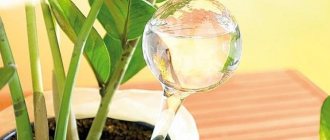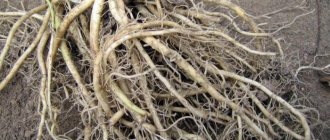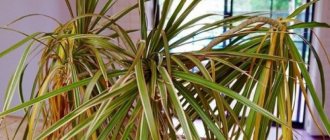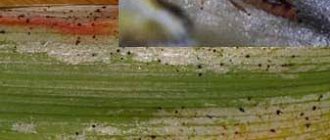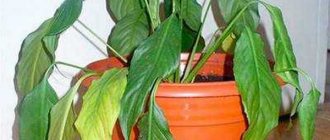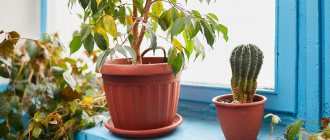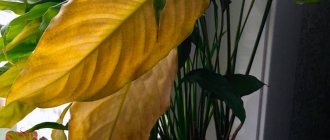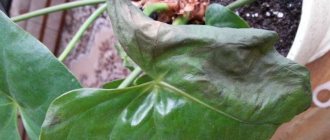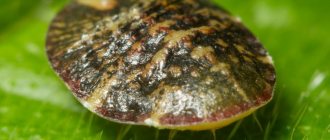Irregular watering
For some indoor plants, proper watering is a fundamental issue. But brown leaf tips can also appear in unpretentious plants. This usually happens when the grower first overwaters the plant so that it drowns, and then barely drizzles the next time.
Houseplants, with the possible exception of succulents, require regular watering. Within one season, the amount of water and frequency of watering should remain constant. You can’t pour a lot once and not enough the second time, because the ground is not as dry as the last time. This will definitely result in brown leaf tips. Pour until water drips from the bottom. Always water at regular intervals.
Brown spots on leaves
Brown spots on the leaves of indoor plants are undoubtedly a concern for gardeners. Most likely, the plant is affected by a fungal disease. Dry brown spots at the beginning of the disease form on the lower leaves, then move to the upper ones. Over time, the spots become darker.
Brown spots on indoor plants
The causes of flower diseases are most often changes in different temperatures, watering with very cold water, and changes in humidity, which consists of alternating dry and humid air. For preventive purposes, plant density should be avoided. It is necessary to thin out the flower in a timely manner, cutting out excess branches and leaves.
It is also necessary to systematically ventilate the room, be it a room or a greenhouse. When placing indoor flowers on the balcony, you need to make sure that it is well ventilated. In addition, a thorough inspection of the walls may reveal a violation of the microclimate. An indicator of a bad atmosphere is the appearance of mold on the walls.
Fungal diseases can be controlled with effective fungicides.
Insufficiently humid air
For indoor plants native to tropical countries, this is the main cause of brown leaf tips. For them, not only regular and abundant watering is important, but also humidity. The problem is especially acute in winter. Fortunately, it's not difficult to solve.
Spray the plant with a spray bottle every day. Fertilizers can be added to the liquid to simultaneously enhance growth or immunity. Another way to solve the humidity issue is to place containers of water next to the pots. You can avoid brown leaf tips by purchasing a humidifier for your home.
Important details
Many types of spotting appear in the second half of summer, but there are also those whose signs are detected shortly after the leaves bloom. High humidity promotes the intensive development of most types of spots. Massive damage by the disease leads to premature drying and falling of leaves, a decrease in the protective and aesthetic functions of plantings of various categories, and an increase in the susceptibility of young plants to frost.
Leaf spot causes significant damage to nurseries, crops and urban plantings.
The spots that form on the leaves can be convex or flat. They are very diverse in shape, size and color, which varies from white to dark brown, almost black. Sporulation of fungi develops on the spots, which infect the leaves during the growing season.
In winter, the causative agents of spotting are stored in the form of mycelium (mycelium) or fruiting bodies on fallen leaves. In the spring, the spores formed on them cause primary infection of the leaves. The more powerful the reserve of overwintering infection, the higher the level of primary and subsequent infections.
Accumulated salts
Brown tips on the leaves of indoor plants can be a signal that a lot of salts have accumulated in the soil. They get into the ground with fertilizers and hard water.
Naturally, plants need fertilizer once or twice a year. But no more. Just as an excess of vitamins and minerals is bad for human health, too much fertilizer will not bring anything good to the plant. After all, more is not always better, and instead of lush, healthy foliage, we end up with brown leaf tips and a wilting plant.
For the same reason, it is worth paying attention to water for irrigation. Ideally it should be distilled. But often just standing for a while is enough. If you water your indoor plants with tap water, it doesn’t hurt to know its hardness.
However, even with proper care, an excellent gardener will not completely avoid the risk of brown leaf tips. Over time, salts accumulate in the soil even with adequate fertilization and good water.
If you are sure that you did everything correctly, but still see brown tips of the leaves, the plant needs to be transplanted into new soil, getting rid of the soil with accumulated salts.
It is also worth mentioning that lack of good drainage and sufficient watering exacerbates the problem. Since the salts do not go to the bottom of the pot.
Spotting
Spot Damage This type of disease affects all leafy plants from trees to lawn grass. First of all, spotting manifests itself in the death of tissue in individual areas of the affected plant organ. This is accompanied by a change in their color and the formation of spots. They are varied in color, size, shape and other characteristics: white, black, brown, other colors, small or large, round, elongated, angular, annular, zonal, flat or convex, dotted, perforated, with or without a border, etc. .d. Spotting has no age limit. They appear on plants of any age, but pose the greatest danger to young plants. The incidence of many blotches can vary greatly from year to year depending on the weather and the condition of individual plants. With a low level of distribution and aggressiveness of pathogens, they do not have a noticeable effect on the decorativeness of trees and shrubs. Systematically repeated severe damage can lead to significant disruption of physiological processes, deformation and drying of leaves and premature (by 1.5 - 2 months) leaf fall. This dramatically weakens the plants and reduces their resistance to other diseases. In some cases, the development of spotting may also affect the state of affairs in any sector of the economy. Thus, when a linden tree is affected by cream spot, honey production sharply decreases.
Non-infectious spots As a rule, these spots arise due to an imbalance of nutrients in the soil at the beginning of the growing season and develop until the end of summer. It is very difficult to establish the cause of non-infectious spotting - different types of plants react differently to a deficiency or excess of the same element in the soil. Spots can form on young or old, light or shadow leaves, in different parts or sectors of the crown, etc. A distinctive feature of non-infectious spotting is the uniform color of the spot and the absence of a border. Only a soil scientist can determine the balance of which soil element is disturbed in the area. Under the influence of transport and industrial emissions, as a result of intensive treatment of the roadway with deicing agents in winter, and other manipulations with chemicals near plants, non-infectious spots occur in the form of a non-infectious burn. It covers the edge of the leaf, parts of the leaf blade along the veins (the so-called “fishbone”) or the entire leaf blade. In this case, the affected areas of the leaves turn brown and dry out.
Spots associated with the development of pathogens Most spots caused by viruses, bacteria, fungi, usually appear en masse in the second half of summer, but some affect leaves already in the middle - end of May (brown spot of poplar leaves, olive spot of rowan leaves, ring spot of elm leaves , red-brown spotting of hawthorn leaves, etc.).
Ring spots, or ring mosaics, are caused by viruses. Numerous whitish or yellow spots in the form of rings form on the affected organs. With severe damage, they can merge and form unusual patterns on the leaf blades. Trees and shrubs are rarely affected by them and without significant consequences. Flower plants with intensive colonization and spread of pathogens (most often carriers are aphids, leafhoppers, bugs, herbivorous mites) die within a few weeks after infection. When plant leaves are damaged by bacteria, spots of angular shape are formed (in accordance with the location of the veins), for example, spotting of leaves and fruits of walnut (Xanthomonas juglandis), spotting of currant leaves (X. heterocea) and others.
The most common are spots of fungal origin (spots of round or indeterminate shape), with pathogen sporulation developing on them. For example, black leaf spots of roses, maple, willow, elm, birch, white (septoria) and brown (marssoniosis) leaf spots of poplar, gray leaf spot of aspen, yellow and brown leaf spot of chestnut, etc. In some cases, with the intensive development of the pathogen, the affected area of the leaf becomes thinner and falls out of the leaf blade (stone fruit cleasterosporiasis). In this case, after the formation of holes in the leaf blades, they are often mistaken for traces of the development of larvae of leaf-eating insects (moths, cutworms, sawflies) and appropriate plant protection techniques are used, which do not have any effect on the pathogen. In addition, holey spotting on the leaves can form as a result of burns with certain fungicides (most often Bordeaux mixture), especially with a large amount of moisture during the spraying period. Also, on poplars, aspen, willows, sea buckthorn, and Rosaceae (apple, pear), spots may be mistaken for the onset of scab development. However, in this case, after the formation of rapidly growing spots on the leaves, young shoots are also affected, which turn black, dry out and bend into hooks, and sometimes break.
Prevention of spotting In order to prevent the appearance of spotting, water the plants on time, wash the crowns, and feed them with fertilizers. Early in the spring, before the buds open, eradicative spraying is carried out on fallen leaves - the source of the primary infection. In this case, aqueous suspensions of Bordeaux mixture, copper sulfate, HOM or other copper-containing preparations are used. Measures to combat spotting When spots appear on the leaves in small quantities, spray with biological preparations Baktofit, Vitaplan, Gamair, Fitosporin-M. In case of severe development of the disease, spraying with copper-containing preparations (Bordeaux mixture, Kuproxat, Abiga-pik, Kuprikol) as well as Fundazol, Skor, Tsikhom, Topaz and others is used.
Before the first use, any drug must be tested on one plant. If the plant’s condition has not worsened within 24 hours, the drug can be used on all protected plants of this species. For greater effectiveness, it is recommended to alternate drugs or mixtures thereof. Be careful when using plant protection products. Always read the label and product information before use. Carry out processing in compliance with all safety rules. Remember, you can remove and consume products from your personal area only 20, or even better, 30 days after the last chemical treatment.
Should I trim off brown leaf tips?
Restoring watering schedules, humidifying the air, and repotting will help prevent brown leaf tips in the future. But what to do with the ones you already have? They will not recover, so it is better to cut them off with sharp scissors or special garden tools.
- 5 mistakes in caring for indoor plants for beginners. Confession of a careless florist
- Why plant leaves turn yellow - 9 common reasons. Indoor plants and plot
Subscribe to our YandexZen channel to find out more!
What to do to revive a flower?
Leaf spotting is a secondary symptom. As a rule, Spathiphyllum signals the appearance of necrosis, rot, fungal and bacterial infections.
The first thing to do is to quarantine the Spathiphyllum and examine it for the presence of fungal spores or pest larvae. After clarifying the nature of the morphological changes in the aerial part and root, treatment begins.
If the spots are dark - brown or brown
Mild damage is caused by improper care; recovery methods are simple :
- The first spring rays of the sun are very intense, young, unhardened leaves of Spathiphyllum get burned. It is important to know that the flower loves diffused (but not direct) light. The optimal place is to install pots on south-eastern windows. Moreover, in the summer heat, the windows are shaded with a transparent curtain or the pots are moved deeper into the room.
- In autumn, due to lack of light, the leaves change pigmentation. Additional lighting is needed to artificially lengthen daylight hours.
- A sheet of foam will save the roots from overcooling. This bedding is placed on the windowsill, and then pots are placed on it. For the winter, you can move the pots onto supports or special tables, away from “frosty” windows.
- It is also important to avoid drafts and flows of cold or hot air (air conditioners, fans); the leaves become stained from sudden temperature changes.
- It is strictly prohibited to water Spathiphyllum with ice water; the tropical resident cannot tolerate the cold.
- If there is a lack of nutrition, it is necessary to apply nitrogen and potassium-phosphorus fertilizers through irrigation; mineral fertilizers alternate with organic ones (mullein solution or bird droppings).
How to treat specific diseases?
- Chlorosis and late blight fungi are transmitted by spore cells that “devour” the entire aerial part; treatment of the soil and bush with antifungal agents (copper sulfate, Bordeaux mixture) is required.
- Bacterial lesions are easier to prevent than to cure; precautions for transplantation or injury-pruning - sterile conditions (processing of planting containers, tools, calcination of the substrate, disinfection of organic fertilizers).
- Viral infections are carried by pests (aphids, scale insects, mites, thrips); The main thing here is not to miss the moment and immediately begin treating the leaves with fungicides and insecticides (Confidor, Actellik, Karbofos, Intavir, etc.).
If the leaves turn black
- Reduce watering (water only when the top layer dries out - up to 10 mm).
- In winter and autumn, watering rates are no more than once every 7-10 days.
- Move the pot to a warm, bright place.
- Optimize the average maintenance temperature - 22-240C, during the rest period - not lower than 150C.
- Ventilate the room - musty, humid air provokes rotting of rosettes and leaves.
- Partially or completely change the soil mixture (raising agents and a drainage layer of 2-3 cm are required).
Attention! The soil in the pot should be loose and moist, and not damp and clayey like plasticine.
Fungal and bacterial black spotting is difficult to treat ; folk remedies are not enough; special antibacterial drugs are needed (Chistotsvet, Baktofit, Topaz, Tsvetolyuks Bau, etc.).
Methods to combat blackening due to overflow and dry air
Flower growers notice blackening of the leaves almost immediately. Initially, damaged leaves should be carefully removed from the bush. The next action must be aimed at eliminating the factors causing the disease.
If the reason lies in dry air, then a simple spray from a spray bottle will help. It is recommended to carry out the procedure in the morning and always with settled water at room temperature. You should not resort to such activities in the evening. The water may not have time to be absorbed, and the coolness of the night will cause hypothermia of the leaves and even their possible rotting.
If a significant amount of dust has accumulated on the leaves, you need to either wipe the greens with a damp sponge or a soft, moisture-absorbing cloth, and it is also recommended to shower periodically.
To do this, the pot should be wrapped in polyethylene, so that the film fits neatly to the stem, while covering the entire soil area. The stream of water must be adjusted so that it is moderate and does not cause damage to young shoots.
In addition, you need to reconsider the degree of watering. If there is an overflow and a musty smell emanates from your pet, you need to change the soil in the flowerpot as soon as possible.
It is recommended to carry out a number of activities:
- Dig up a bush
- Free the root from the soil
- Inspect the root system for rotting or damage
- Trim off all diseased roots
- Cuts must be sprinkled with ash or charcoal to prevent the spread of infection.
- Purchase or independently prepare a substrate for planting a reanimated pet
It is important to prepare the pot for replanting. It needs to be thoroughly washed with soda and poured with boiling water so that there are no pathogenic bacteria on its walls. It is necessary to place drainage at the bottom. Then plant according to all the rules.
